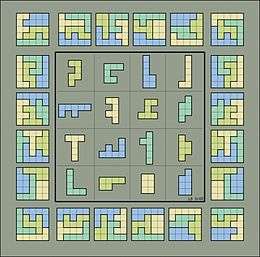Lee Sallows
| Lee Sallows | |
|---|---|
 | |
| Born |
April 30, 1944 (age 73) Welwyn, Hertfordshire |
| Residence | Nijmegen, The Netherlands |
| Nationality | English |
| Fields | Recreational mathematics |
| Known for |
Golygons Alphamagic squares Geometric magic squares Self-tiling tile sets Self-enumerating sentences |
Lee Cecil Fletcher Sallows (born April 30, 1944) is a British electronics engineer known for his contributions to recreational mathematics. He is particularly noted as the inventor of golygons, self-enumerating sentences, and geomagic squares.
Recreational mathematics
Sallows is an expert on the theory of magic squares[1] and has invented several variations on them, including alphamagic squares[2][3] and geomagic squares.[4] The latter invention caught the attention of mathematician Peter Cameron who has said that he believes that "an even deeper structure may lie hidden beyond geomagic squares"[5]
In "The lost theorem" published in 1997 he showed that every 3 × 3 magic square is associated with a unique parallelogram on the complex plane, a discovery that had escaped all previous researchers from ancient times down to the present day.[6] In 2014 Sallows discovered a previously unnoticed result involving the medians of a triangle.[7]
A golygon is a polygon containing only right angles, such that adjacent sides exhibit consecutive integer lengths. Golygons were invented and named by Sallows[8] and introduced by A.K. Dewdney in the Computer Recreations column of the July 1990 issue of Scientific American.[9]
In 2012 Sallows invented and named self-tiling tile sets—a new generalization of rep-tiles.[10]

Personal life
Lee Sallows is the only son of Florence Eliza Fletcher and Leonard Gandy Sallows. He was born on 30 April 1944 at Brocket Hall in Hertfordshire, England, and grew up in the district of Upper Clapton in northeast London. Sallows attended Dame Alice Owen's School, then located at The Angel, Islington, but failed to settle in and was without diplomas when he left at age 17. Knowledge gained via interest in short-wave radio enabled him to find work as a technician within the electronics industry. In 1970 he moved to Nijmegen in the Netherlands, where until 2009, he worked as an electronic engineer at Radboud University. In 1973 Sallows met up with his Dutch partner Evert Lamfers, now a cardiologist, with whom he has lived ever since.
Bibliography
- 2014 Sallows, Lee "More On Self-tiling Tile Sets", Mathematics Magazine, April 2014
- 2012 Sallows, Lee. "On Self-Tiling Tile Sets", Mathematics Magazine, December, 2012
- 2012 "Geometric Magic Squares: A Challenging New Twist Using Colored Shapes Instead of Numbers", Dover Publications, ISBN 0486489094
- 1997 "The Lost Theorem", The Mathematical Intelligencer 1997 19; 4: 51–54.
- 1995 "The Impossible Problem", The Mathematical Intelligencer 1995 17; 1: 27–33.
- 1994 "Alphamagic Squares", In: The Lighter Side of Mathematics pp 305–39, Edited by R.K. Guy and R.E. Woodrow, pub. by The Mathematical Association of America, 1994, ISBN 0-88385-516-X
- 1992 Sallows, Lee (1992). "New pathways in serial isogons". The Mathematical Intelligencer. 14: 55–67. doi:10.1007/BF03025216.
- 1991 Sallows, Lee; Gardner, Martin; Guy, Richard K.; Knuth, Donald (1991). "Serial isogons of 90 degrees". Mathematics Magazine. 64 (5): 315–324. JSTOR 2690648. doi:10.2307/2690648.
- 1990 "A Curious New Result in Switching Theory", The Mathematical Intelligencer 1990; 12: 21–32.
- 1987 "In Quest of a Pangram", In: A Computer Science Reader, pp 200–20, Edited by EA Weiss, Springer-Verlag, New York, ISBN 0-387-96544-0
- 1986 "Co-Descriptive Strings", (Lee Sallows & Victor L Eijkhout), Mathematical Gazette 1986; 70: 1–10
References
- ↑ Magic Square Update-2009, September 6, 2009
- ↑ alphamagic square, Encyclopedia of Science
- ↑ excerpt from Word Play by Martin Gardner
- ↑ Magic squares are given a whole new dimension, The Observer, April 3, 2011
- ↑ Ancient puzzle gets new lease of 'geomagical' life, New Scientist, January 24, 2011
- ↑ The lost theorem In The Mathematical Intelligencer, Fall 1997, Vol 19, Issue 4, pp 51-54
- ↑ Sallows, Lee, "A Triangle Theorem" Mathematics Magazine, Vol. 87, No. 5 (December 2014), p. 381
- ↑ Serial isogons of 90 degrees, by Lee Sallows, Martin Gardner, Richard Guy, and Donald Knuth, Mathematics Magazine, Vol. 64, No. 5, December, 1991
- ↑ "What is a Golygon?". Archived from the original on October 27, 2009. Retrieved 2010-10-08.
- ↑ On Self-Tiling Tile Sets, by Lee Sallows,, Mathematics Magazine, Vol. 85, No. 5, December 2012